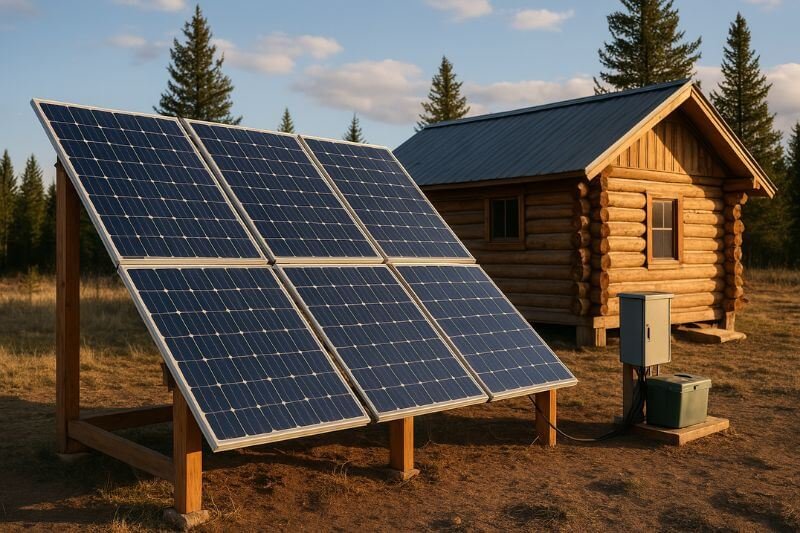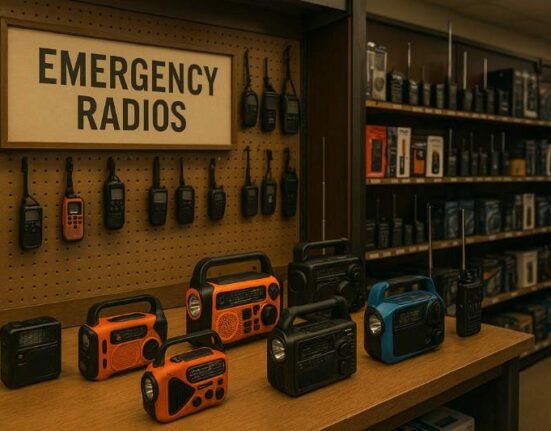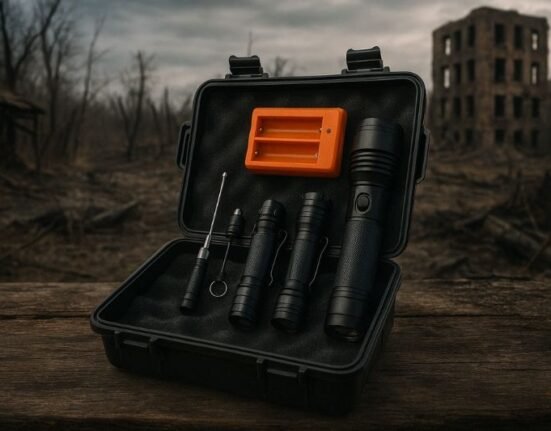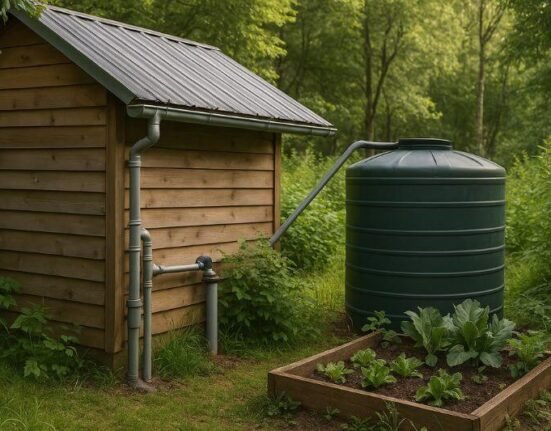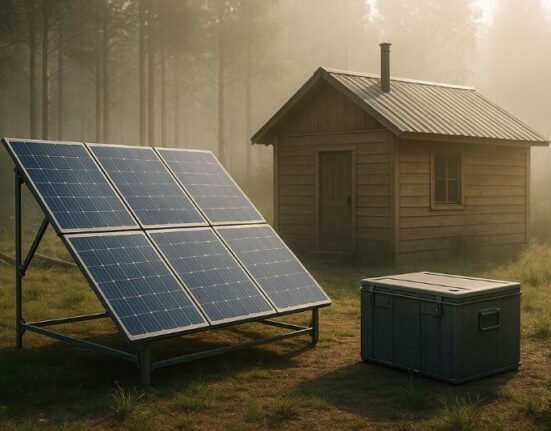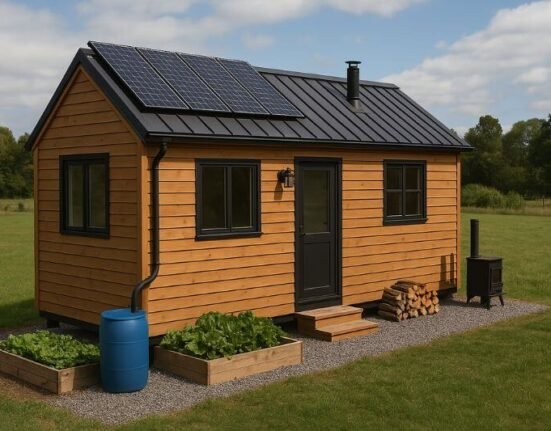In today’s uncertain world, off-grid solar power is no longer just for remote cabins or hardcore preppers. It’s becoming a strategic choice for anyone seeking energy independence in the face of rising utility costs, climate instability, and potential grid failure. Whether you’re prepping for long-term survival or simply reducing your reliance on centralized systems, going solar off the grid is a powerful step toward resilience.
This comprehensive guide will walk you through every crucial aspect — from the technology and planning to real-life applications — all grounded in field-tested experience and expert recommendations.
🔋 Partie 1 : Comprendre le système solaire hors-réseau
⚙️ How Off-Grid Solar Power Works
Off-grid solar systems function independently of public utilities. They rely on solar panels to convert sunlight into electricity, which is then stored in batteries and regulated through charge controllers and inverters.
Key components of an off-grid solar setup:
- Solar panels: Capture sunlight and generate DC electricity.
- Charge controller: Regulates the current to protect battery health.
- Battery bank: Stores energy for use when the sun isn’t shining.
- Inverter: Converts DC to usable AC power for standard appliances.
“A properly designed off-grid system allows total energy autonomy — but improper sizing or poor storage management is the number one failure point.” — National Renewable Energy Laboratory (NREL)
🧠 Grid-Tied vs Off-Grid vs Hybrid Systems
| System Type | Grid Connection | Battery Storage | Ideal Use Case |
|---|---|---|---|
| Grid-Tied | ✅ Yes | ❌ No | Urban homes seeking lower bills |
| Hybrid | ✅ Yes | ✅ Yes | Backup for outages, partial use |
| Off-Grid | ❌ No | ✅ Yes | Remote, resilient living |
Off-grid systems are fully autonomous. You’re responsible for generating, storing, and managing your entire energy load — which means accurate planning is critical.
🔍 Estimating Your Energy Needs
Before you even buy your first panel, you need a clear picture of your consumption. Here’s how:
- List all appliances you plan to run.
- Note their wattage (e.g., a laptop uses ~50W, a fridge ~150W).
- Estimate usage hours per day.
- Calculate total daily watts needed.
✅ Example:
| Appliance | Watts | Hours/Day | Daily Consumption |
|---|---|---|---|
| LED lights (5x) | 10W | 4h | 200 Wh |
| Laptop | 50W | 5h | 250 Wh |
| Fridge | 150W | 10h | 1500 Wh |
| Total | 1950 Wh/day |
Now add 20–30% margin for battery loss and inverter inefficiency.
⚠️ Common Mistakes to Avoid in Planning
- Underestimating energy needs: Most beginners go too small. Always oversize slightly.
- Ignoring winter sun hours: Solar output can drop by half or more in cold climates.
- Cheap batteries: Low-quality batteries die fast. Lithium or AGM deep-cycle batteries last longer.
FEMA recommends off-grid setups in disaster-prone regions to ensure power for critical medical or communication devices during blackouts【source】.
🔩 Types of Solar Panels: What to Choose
| Type | Efficiency | Durability | Cost | Best For |
|---|---|---|---|---|
| Monocrystalline | ✅ High | ✅ Long | 💲💲💲 | All climates, compact use |
| Polycrystalline | ➖ Medium | ✅ Good | 💲💲 | Warm zones, larger roofs |
| Thin Film | ❌ Low | ❌ Low | 💲 | Temporary or mobile setups |
Tip: If you’re building in a permanent location, monocrystalline panels are a solid investment.
📦 Off-Grid Starter Kit: What You Need
Here’s a checklist of core components for a basic off-grid system:
- Solar Panels (at least 400W to start)
- MPPT Charge Controller (high-efficiency)
- Inverter (pure sine wave, 1000W+)
- Battery Bank (minimum 100Ah at 12V)
- Wiring, fuses, disconnects
- Mounting hardware
- Backup Generator (optional but smart)
➡️ Internal Link Suggestion: Bug Out Cabin Power Setup Checklist – CivilFall.com/survival-guides/bug-out-and-evacuation
🔧 Real-World Example: Off-Grid Power in Action
Case Study – Desert Homestead, Arizona
Mike and Sarah built their off-grid cabin on 2 acres in Arizona. With just 4 x 100W panels, a 200Ah battery bank, and a propane backup generator, they powered:
- Lights
- Laptop + Starlink internet
- Fridge
- Small AC unit (3 hrs/day)
“We adjusted our lifestyle to our system’s capacity. It’s freeing — not limiting.” – Mike G., off-grid homesteader
⚒️ Part 2: Installing and Setting Up Your Off-Grid Solar Power System
🏗️ Step-by-Step Guide to Off-Grid Solar Installation
Once you understand the components, the next critical phase is putting them together — correctly and safely. Based on field practices and solar installation standards (Solar Energy Industries Association), here’s how to build a durable off-grid solar setup from scratch.
☀️ Step 1 – Choose the Optimal Panel Location
Your panels are only as good as their exposure to sunlight. Choose a location with full southern exposure (in the northern hemisphere) and no shade at any point during the day.
Best practices:
- Angle your panels based on your latitude (e.g., 35° if you’re in Arizona).
- Keep panels at least 12 inches (30 cm) off the roof for airflow.
- Avoid placing near chimneys, trees, or satellite dishes.
Tip: Use a sun path tool (like SunCalc) to map shadows across seasons.
🔌 Step 2 – Wiring and Electrical Setup
This is the backbone of your energy system. Every component should be properly sized, fused, and protected.
Basic Wiring Flow:
nginxCopierModifierSolar Panels → Charge Controller → Battery Bank → Inverter → AC Appliances
Safety Checklist:
- 🔋 Use correct gauge wires (10 AWG or thicker for high loads)
- 🔧 Install inline fuses or circuit breakers between each component
- 🌐 Include grounding rods to protect from lightning or faults
“Poor wiring causes 80% of DIY system failures. If in doubt, overbuild.” — Off-Grid Solar Technician Field Manual, 2022
🔋 Deep Dive: Battery Selection and Configuration
Your battery bank determines how long you can stay powered when the sun isn’t shining.
| Battery Type | Pros | Cons | Lifespan |
|---|---|---|---|
| AGM Lead-Acid | Affordable, easy to maintain | Heavy, limited deep cycles | 3–5 years |
| Gel Cell | Spill-proof, better in hot climates | Slower charge/discharge | 4–6 years |
| Lithium (LiFePO4) | Lightweight, long lifespan | High initial cost | 10–15 years |
Recommendation: If budget allows, go for LiFePO4 batteries. They charge faster, last longer, and handle deeper discharges.
⚠️ Mistakes to Avoid During Setup
Here are the most common traps that ruin off-grid builds:
- Mixing battery types: Always use the same model and age in a bank.
- Mounting panels too flat: Low tilt equals dust buildup and poor winter performance.
- Skipping breakers: This is dangerous — always use fuses or disconnects.
- Overloading the inverter: Stay below 80% of rated power for long-term use.
🔧 Mounting & Hardware Tips
A good mount doesn’t just hold panels — it protects your investment.
Types of Mounts:
- Roof-Mounted: Easy to install, but harder to clean and cool.
- Ground-Mounted: Best for maintainability, scalable.
- Pole-Mounted: Excellent for rotating toward the sun.
✅ Use anti-corrosion brackets, stainless steel bolts, and weather-sealed junction boxes.
🔋 Off-Grid Load Prioritization: What to Power First
In an off-grid system, load management is survival. Not everything should be powered at once.
Start with priority devices:
- Refrigerator or chest freezer
- Water pump
- Lighting (LED)
- Communications (radio, satellite internet)
- Charging stations (phones, lanterns)
Then add extras like:
- TV, fans, tools, small appliances
“Survival is about power allocation, not just power generation.” — PrepperTech Journal, 2023
🛠️ Real-Life Setup Example: Forest Cabin in Maine
Anna and Rob, off-grid homesteaders in northern Maine, built a system for under $6,000:
- 6 x 200W monocrystalline panels
- 4 x 100Ah LiFePO4 batteries
- 60A MPPT controller
- 3000W pure sine inverter
- Backup propane generator
They live comfortably with lights, internet, a fridge, and tools — and use just 1 hour of generator time per week in winter.⚒️ Part 2: Installing and Setting Up Your Off-Grid Solar Power System
🏗️ Step-by-Step Guide to Off-Grid Solar Installation
Once you understand the components, the next critical phase is putting them together — correctly and safely. Based on field practices and solar installation standards (Solar Energy Industries Association), here’s how to build a durable off-grid solar setup from scratch.
☀️ Step 1 – Choose the Optimal Panel Location
Your panels are only as good as their exposure to sunlight. Choose a location with full southern exposure (in the northern hemisphere) and no shade at any point during the day.
Best practices:
- Angle your panels based on your latitude (e.g., 35° if you’re in Arizona).
- Keep panels at least 12 inches (30 cm) off the roof for airflow.
- Avoid placing near chimneys, trees, or satellite dishes.
Tip: Use a sun path tool (like SunCalc) to map shadows across seasons.
🔌 Step 2 – Wiring and Electrical Setup
This is the backbone of your energy system. Every component should be properly sized, fused, and protected.
Basic Wiring Flow:
nginxCopierModifierSolar Panels → Charge Controller → Battery Bank → Inverter → AC Appliances
Safety Checklist:
- 🔋 Use correct gauge wires (10 AWG or thicker for high loads)
- 🔧 Install inline fuses or circuit breakers between each component
- 🌐 Include grounding rods to protect from lightning or faults
“Poor wiring causes 80% of DIY system failures. If in doubt, overbuild.” — Off-Grid Solar Technician Field Manual, 2022
🔋 Deep Dive: Battery Selection and Configuration
Your battery bank determines how long you can stay powered when the sun isn’t shining.
| Battery Type | Pros | Cons | Lifespan |
|---|---|---|---|
| AGM Lead-Acid | Affordable, easy to maintain | Heavy, limited deep cycles | 3–5 years |
| Gel Cell | Spill-proof, better in hot climates | Slower charge/discharge | 4–6 years |
| Lithium (LiFePO4) | Lightweight, long lifespan | High initial cost | 10–15 years |
Recommendation: If budget allows, go for LiFePO4 batteries. They charge faster, last longer, and handle deeper discharges.
⚠️ Mistakes to Avoid During Setup
Here are the most common traps that ruin off-grid builds:
- Mixing battery types: Always use the same model and age in a bank.
- Mounting panels too flat: Low tilt equals dust buildup and poor winter performance.
- Skipping breakers: This is dangerous — always use fuses or disconnects.
- Overloading the inverter: Stay below 80% of rated power for long-term use.
🔧 Mounting & Hardware Tips
A good mount doesn’t just hold panels — it protects your investment.
Types of Mounts:
- Roof-Mounted: Easy to install, but harder to clean and cool.
- Ground-Mounted: Best for maintainability, scalable.
- Pole-Mounted: Excellent for rotating toward the sun.
✅ Use anti-corrosion brackets, stainless steel bolts, and weather-sealed junction boxes.
🔋 Off-Grid Load Prioritization: What to Power First
In an off-grid system, load management is survival. Not everything should be powered at once.
Start with priority devices:
- Refrigerator or chest freezer
- Water pump
- Lighting (LED)
- Communications (radio, satellite internet)
- Charging stations (phones, lanterns)
Then add extras like:
- TV, fans, tools, small appliances
“Survival is about power allocation, not just power generation.” — PrepperTech Journal, 2023
🛠️ Real-Life Setup Example: Forest Cabin in Maine
Anna and Rob, off-grid homesteaders in northern Maine, built a system for under $6,000:
- 6 x 200W monocrystalline panels
- 4 x 100Ah LiFePO4 batteries
- 60A MPPT controller
- 3000W pure sine inverter
- Backup propane generator
They live comfortably with lights, internet, a fridge, and tools — and use just 1 hour of generator time per week in winter.
🌱 Part 3: Maintenance, Expansion, and Long-Term Sustainability
🔁 Maintenance for Off-Grid Solar Power Systems
An off-grid solar power system isn’t a “set it and forget it” deal — it demands routine care to ensure reliability.
Weekly Tasks:
- Check battery voltage and inverter output
- Inspect panels for debris, dust, or snow
- Monitor charge controller for warnings or errors
Monthly Tasks:
- Tighten cable connections
- Clean solar panels (use distilled water + microfiber cloth)
- Check battery terminals for corrosion
Every 6–12 Months:
- Load test batteries
- Check charge controller firmware
- Inspect the integrity of mounting brackets
According to the Department of Energy, regular maintenance extends system life by 30% or more.
🧠 Troubleshooting Common Off-Grid Issues
Living off-grid means becoming your own technician. These are the top issues you’ll likely face:
| Problem | Cause | Fix |
|---|---|---|
| Low battery voltage | Overuse or lack of sun | Reduce load, wait for sun, use generator |
| Inverter shuts down randomly | Overload or overheating | Check specs, clean vents, reduce load |
| Solar panels underperforming | Shading or dirty panels | Relocate or clean panels |
| Batteries not charging fully | Controller misconfigured | Reset MPPT, check wiring and settings |
✅ Pro tip: Use a solar monitoring app (like VictronConnect or Renogy BT) to track performance remotely.
📡 Scaling Up: When Your Needs Grow
Many preppers and off-grid families start small — but quickly realize they need more power. Here’s how to scale smart:
🪜 Modular Expansion Steps:
- Add more panels in parallel or series (ensure voltage match)
- Upgrade the charge controller (MPPTs scale better than PWM)
- Expand your battery bank (same type, age, and brand!)
- Upgrade to a higher-capacity inverter (3000W → 5000W)
Important: Always calculate your new energy demand before scaling. A badly balanced expansion can create system stress or component failure.
🔒 Off-Grid System Security & Backup
Nature isn’t the only threat — your system is vulnerable to theft, EMPs, and severe weather.
Security Measures:
- Lockable battery boxes or sheds
- Camouflaged solar installations (especially in remote BOLs)
- Physical alarms or cameras
EMP Protection:
- Store a spare charge controller and inverter in a Faraday cage
- Use surge protectors on all DC and AC lines
Storm Resilience:
- Tilt panels to reduce wind load
- Anchor mounts with concrete or ground screws
- Waterproof all junction boxes
FEMA guidelines recommend installing solar backup systems in hurricane and wildfire zones as critical infrastructure.
📈 Advanced Optimization Tips
To get the most out of your system year-round:
- Install a tilt-adjustable mount to change angle seasonally
- Use DC appliances (fridge, fans) to skip inverter loss
- Set timers for energy-hungry devices to run during peak sun hours
- Monitor weather patterns for manual load management
- Combine solar with wind or micro-hydro for hybrid setups
🧭 Resources for Further Learning
🔗 Internal Links to Include:
- Bug Out Cabin Power Setup
- Long-Term Survival Supplies
- Resilience Training for Off-Grid Living
- Water Filtration Systems Off the Grid
✅ Conclusion: Take Control of Your Power, Take Control of Your Future
Off-grid solar power isn’t just a technical setup — it’s a mindset shift. You’re not just unplugging from the grid; you’re reclaiming responsibility for your security, sustainability, and sovereignty.
Start with what you can afford. Scale as you learn. And remember — resilience doesn’t mean perfection, it means adapting smarter every day.
Whether you’re building a bug out retreat, prepping for economic collapse, or just want to be less dependent on fragile infrastructure, off-grid solar power is one of the smartest moves you can make.
❓ Frequently Asked Questions (FAQ) – Off-Grid Solar Power
Q: How much does an off-grid solar system cost to install realistically?
This is often the first question asked — and it’s also the most misunderstood.
A basic off-grid solar power system for a small cabin or bug-out shelter can be built for as little as $1,500 to $3,000, assuming you’re doing most of the installation yourself and running only essential devices like LED lights, a laptop, a fridge, and a water pump. These setups typically include 400–800W of solar panels, a modest lithium battery bank, an MPPT charge controller, and a pure sine inverter.
However, if you’re aiming for full-home off-grid living — running multiple appliances, power tools, refrigeration, communications, and heating — you’re likely looking at $10,000 to $20,000+. Here’s a general price breakdown for mid-range systems:
| Component | Approx. Cost (USD) |
|---|---|
| Solar panels (2000W) | $1,500 – $3,000 |
| Lithium battery bank | $4,000 – $8,000 |
| Inverter (3000–5000W) | $800 – $2,000 |
| MPPT charge controller | $200 – $500 |
| Mounting hardware | $300 – $700 |
| Wiring, fuses, boxes | $300 – $800 |
| Backup generator | $700 – $2,000 (optional) |
🛠️ Pro Tip: Start with a smaller scalable system and expand as you learn. The biggest mistake is to overbuild and then underutilize.
Q: Is it legal to go completely off-grid in a city or suburban neighborhood?
Technically, yes. Practically, it’s complicated.
Urban zoning laws, building codes, and utility regulations often make full disconnection illegal or financially punitive. In many municipalities, your home must remain grid-connected to comply with insurance requirements, fire code regulations, or resale certifications.
However, what is legal and practical in most areas is to build a hybrid system — one that still connects to the grid but allows you to run fully on your own solar energy when needed. These systems include solar panels, a battery bank, and an inverter — and can be switched manually or automatically in the event of a grid failure.
🏙️ In cities:
- Grid-tie with battery backup is your best legal option.
- Some solar energy credits or rebates may be available.
🌲 In rural areas:
- Many counties and unincorporated regions allow full off-grid living.
- No utility connection = no monthly bills, no external dependencies.
According to The Solar Foundation, over 180,000 households in the U.S. live fully off-grid as of 2024, mostly in Alaska, Montana, New Mexico, and parts of Appalachia.
Q: Do I need permits to build an off-grid solar system?
The need for permits depends on your location, scope, and whether you’re connected to the grid.
If you’re going fully off-grid on private land in a rural zone, you may not need permits — especially if the installation is small, doesn’t tie into utility lines, and doesn’t impact septic or plumbing systems. Many off-gridders simply install their systems under the radar. That said, it’s your responsibility to check:
Typical permits (when required):
- Electrical permit (for AC wiring, inverters)
- Structural permit (if roof-mounted)
- Zoning variance (for solar farms or commercial-size setups)
🔒 If you’re renting land or living in an HOA-controlled area, you may face stricter limitations or even outright bans on visible solar arrays.
FEMA suggests checking with your local building department, as code enforcement varies wildly — even between towns in the same county.
Q: What happens during long periods of cloud cover or snow?
This is where most “armchair preppers” get humbled. Solar power is reliable — but it’s not infinite, and it’s highly seasonal in most climates.
On cloudy days:
- Solar panel efficiency can drop by 30% to 80% depending on cloud density.
- Your system will still produce power, but it may be insufficient for high-consumption devices.
In snowy conditions:
- Snow accumulation completely blocks sunlight.
- Panels must be physically cleared — some people use soft brooms or heated panel systems.
- Cold temperatures can improve solar panel efficiency once cleared.
How do you handle it?
- Oversize your system to accommodate worst-case sunlight hours (e.g., 2–3 hrs/day in winter).
- Invest in a high-capacity battery bank that stores 3–5 days of power.
- Use a backup generator (propane, diesel, or dual-fuel) to recharge batteries.
- Add a second power source like wind or hydro if available.
🔄 Diversification = true resilience.
Q: Can I build an off-grid solar system myself or should I hire a professional?
Yes, you can absolutely build it yourself — and many off-gridders do. But you’ll need to be:
- Comfortable with basic electrical wiring
- Familiar with DC and AC systems
- Willing to read manuals, watch tutorials, and triple-check safety
The good news: most components today are plug-and-play or come with detailed instructions.
However, for larger systems or rooftop installations, consider hiring a certified installer — at least for the high-voltage connections. Mistakes here aren’t just inconvenient, they can be dangerous or deadly.
Tip from the field: “Build it yourself if you can afford to experiment. Hire someone if you’re powering life-saving devices or mission-critical equipment.”
Q: How long will my off-grid solar system last?
It depends on your component quality and how well you maintain it.
Estimated lifespan by component:
| Component | Lifespan |
|---|---|
| Solar Panels | 25–30 years |
| MPPT Controller | 10–15 years |
| Lithium Batteries | 10–15 years |
| AGM Batteries | 3–6 years |
| Inverter | 8–12 years |
🧽 Routine maintenance (checking connections, cleaning panels, monitoring charge cycles) can add years to your system’s life.
Q: Is off-grid solar power enough to live normally?
Yes — but only if your “normal” includes energy awareness.
People who thrive off-grid:
- Use LED lights, not incandescent bulbs
- Cook with propane or wood, not electric stoves
- Use gravity-fed water systems when possible
- Adapt their routines to sunlight hours
With careful design, you can still run:
- Laptops, routers, radios
- Refrigeration
- Fans and low-wattage heating
- Even well pumps, freezers, and washing machines — if sized correctly
But you’ll need to let go of some luxury appliances:
- Air fryers, hairdryers, space heaters, clothes dryers — these are power hogs in an off-grid world.
🧠 Final Thought
Off-grid solar power is not a fantasy. It’s not just for remote hermits or rich eco-warriors. It’s a practical, achievable solution for those who want to be less vulnerable in an unstable world.
But like all forms of resilience, it requires knowledge, commitment, and adaptability. The power to thrive off-grid isn’t just in your batteries — it’s in how well you prepare, maintain, and evolve your system.
Ready to reclaim your power?
👉 Explore our full Off-Grid Living section
👉 Get started with a bug-out power setup here









